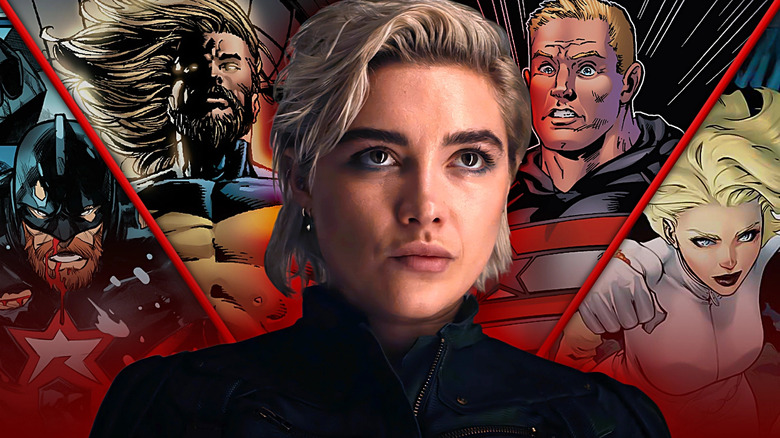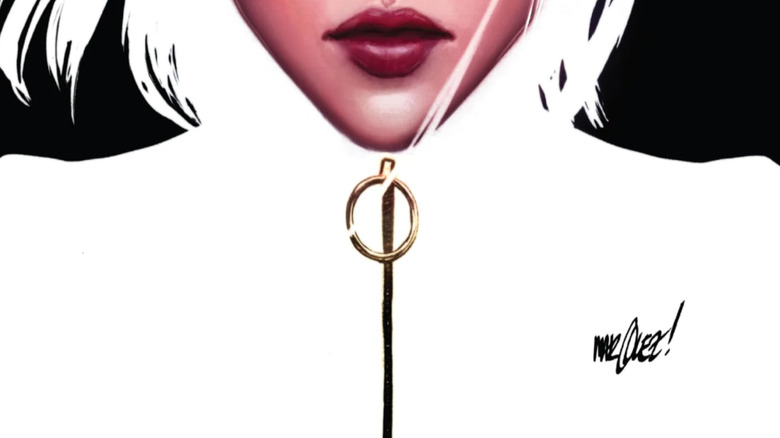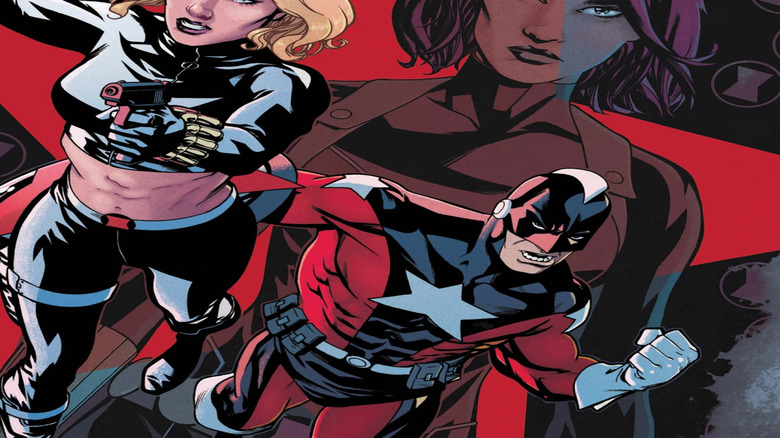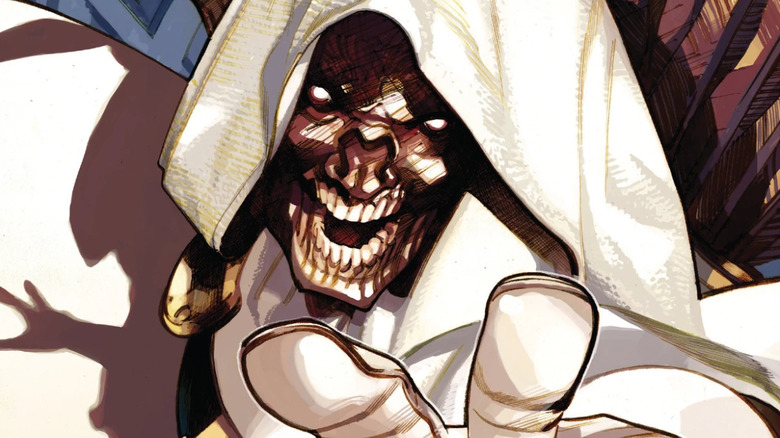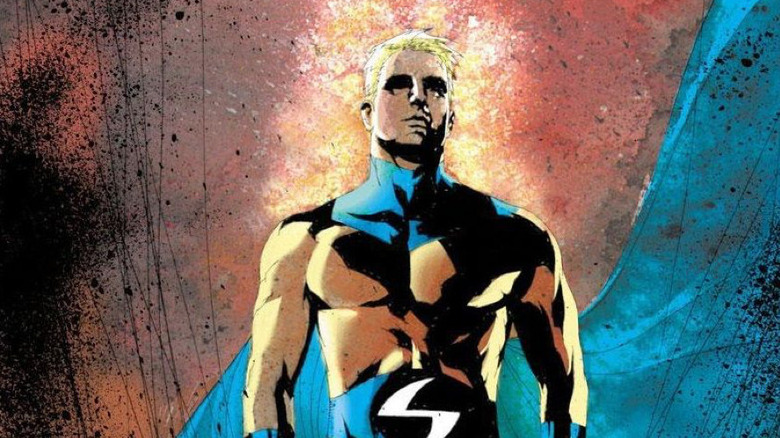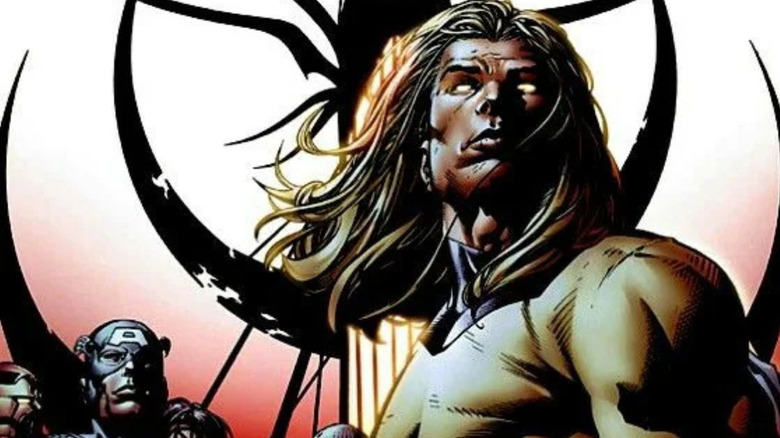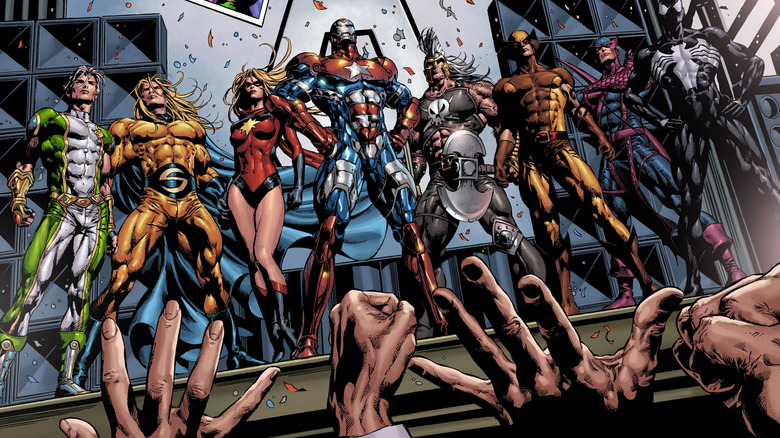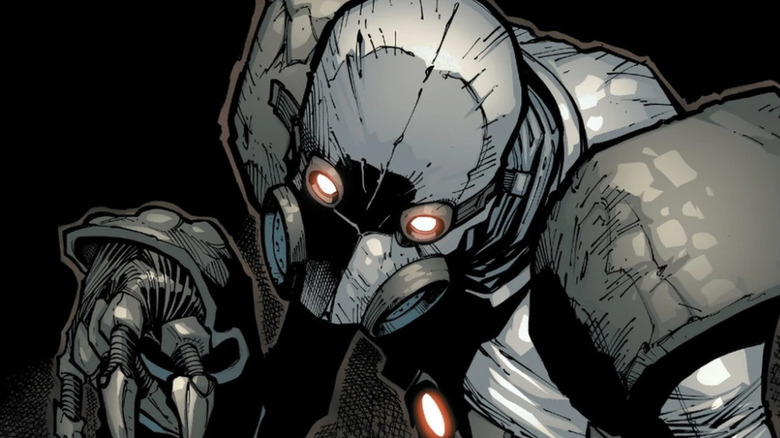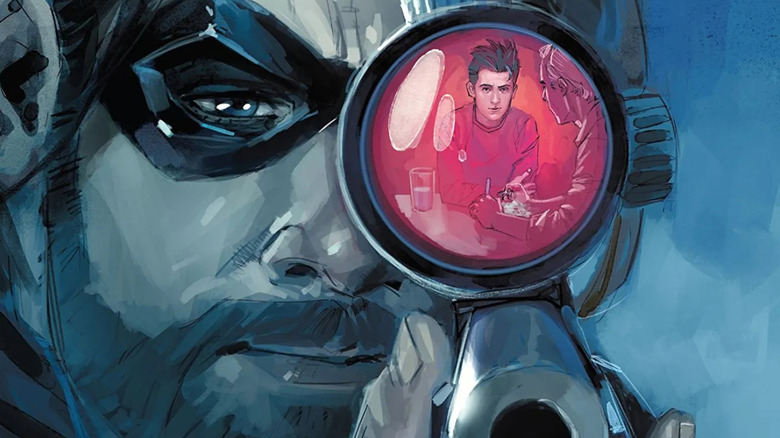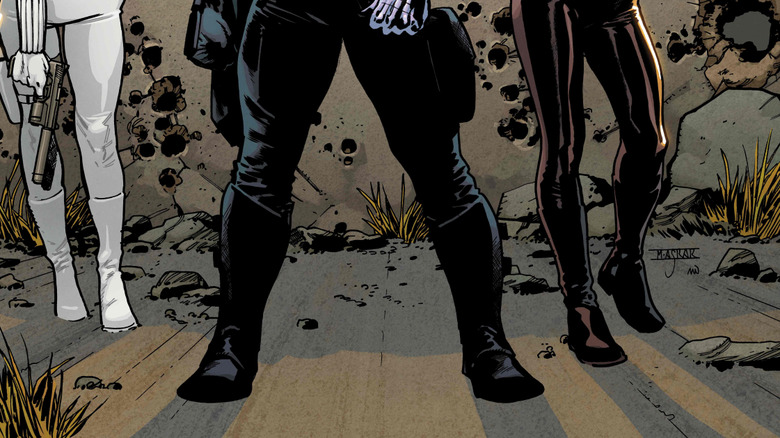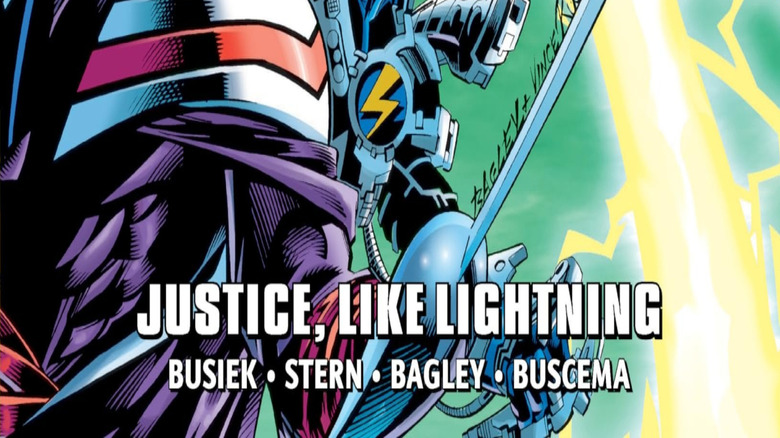10 Marvel Comic Books You Need To Read After Thunderbolts
After a slew of disappointing movies and TV shows, it seems as though "Thunderbolts*" has finally put the Marvel Cinematic Universe back on track. The film breaks away from recent outings by engaging with complex themes like depression, addiction, and mental illness, and overall imbuing its characters with more depth and humanity (a victory thanks in no small part to stars Florence Pugh, Sebastian Stan, and Lewis Pullman).
In the wake of such a successful character-driven entry in the MCU, fans are likely anxious to spend more time with the likes of Yelena, Bucky, and the Sentry — and maybe don't want to wait until "Avengers: Doomsday" to do so. Fortunately for them, Marvel Comics has back issues upon back issues to catch up on. From the currently running "Thunderbolts: Doomstrike" series to the 10 comic books, storylines, and trade paperbacks we list below, there are plenty of options for fans who want to revisit these characters and boost the writers and artists who created them in the first place.
White Widow: Welcome to Idylhaven
If "Thunderbolts*" have made you as obsessed with Florence Pugh's take on Yelena Belova as we are, then you need to check out "White Widow." In the comics, the successor to Natasha Romanoff has historically been written in a much darker tone compared to her MCU counterpart. She's often used as a means of showcasing what a true, ruthless assassin looks like in contrast to the more heroic Avenger. Because Yelena is introduced in the MCU essentially after Natasha's (Scarlett Johansson) death in "Avengers: Endgame," she had to immediately be a likable character capable of carrying her own adventures — and perhaps even leading her own team — in future films and television shows.
This journey to becoming a marquee superhero took Yelena much longer in the comics, and, honestly, seemingly only came about as a consequence of the popularity brought on by her MCU adaptation. As such, Marvel and writer Sarah Gailey smartly use "White Widow" to redefine Yelena's characterization so it fits closer to the endearing yet unyielding assassin MCU fans will expect from "Thunderbolts*." Her sense of humor, personal values, and moral framework are the key changes, and we feel they're ultimately to the benefit of a character who has otherwise been stuck in the periphery since she debuted in the late '90s.
Sadly, "White Widow" only ran for four issues, compiled in "White Widow: Welcome to Idylhaven." This story follows Yelena as she attempts to start a new life as an assassin consultant in the suburbs of Idylhaven, only for her community to be upended by the mysterious and insidious "Armament" organization and the villainous supergroup B.A.D. Girls Inc. The series also explores Yelena's past in this new context, featuring appearances from major heroes like Captain America, She-Hulk, and Wolverine.
Widowmakers: Red Guardian and Yelena Belova
If you're looking for a Yelena Belova story that's a bit closer to how she is traditionally presented in the comics, "Widowmakers: Red Guardian and Yelena Belova" is a perfect jumping-off point to get acclimated to this version of the character. The 2020 one-shot (published during the lead-up to the release of the "Black Widow" film that same year, though set in Marvel Comics continuity) is written by Devin Grayson, a comics vet who gained prominence for her work on DC Comics like "Nightwing," "The Titans," and "Gotham Knights." However, she also notably co-created Yelena Belova with artist J.G. Jones for the 1999 Marvel Knights series "Black Widow."
Contrary to Sarah Gailey's "White Widow," Grayson picks up right where she left off with Yelena, tonally speaking, in "Widowmakers." This is the tragic, remorseless killer who has been operating in the margins of the Marvel Universe for well over two decades now (though, perhaps because of the current audience expectations for the post-MCU Marvel Comics, there is somewhat of a softening to the character even so).
Of course, as the title implies, the issue also prominently features the Red Guardian himself Alexei Shostakov (David Harbour's character from "Black Widow" and "Thunderbolts*"). He's far from the gregariously goofy and embarrassing enthusiastic father figure we've come to know from his appearances in the MCU, instead presented as a stoic super soldier similar to the likes of U.S. Agent and certain takes on Captain America. That said, given that there has yet to be a comic that fully embraces and showcases the Red Guardian popularized by "Black Widow" and "Thunderbolts*," it's a decent enough introduction to the character that should satisfy a new fan's curiosity.
Taskmaster: Unthinkable
The promotional period for "Black Widow" in 2020 also saw the release of a brand new "Taskmaster" comic from Jed MacKay, Alessandro Vitti, and Guru-eFX meant to capitalize on excitement for the character's live action debut. It's a pretty great contemporary read, with MacKay nailing the Tony Masters voice and showcasing the skills that would quickly make him a fan favorite Marvel writer in the 2020s.
However, it's an adventure story for the most part that doesn't get too close to the heart of the character — for that, new fans will want to go back to the 2010 miniseries "Taskmaster: Unthinkable." With Fred Van Lente at the helm and Jefte Palo on art duties, Taskmaster is propped up to do what he does best — beat the absolute snot out of hordes of diverse enemies with personal hatred for him, usually all at once. It's a key part of the character's appeal that we don't get to see in the Marvel Cinematic Universe, as Taskmaster (played by a tragically wasted Olga Kurylenko) is just an emotionally and physically robotic cyborg who — spoiler alert for "Thunderbolts*" — has already been definitively killed off.
It's a real shame, because even the bland MCU Taskmaster could have been reworked a little to become much more compelling using elements from "Unthinkable," particularly the revelation that, as a result of his photographic reflexive memory, Tony Masters actually suffers from declarative memory loss. It's a fascinating wrinkle to make an exciting villain like Taskmaster psychologically complex, and the further, heartbreaking exploration of this trait in "Avengers Academy" (in which we learn that he can't even remember his own daughter, standing in front of him) goes to show how much potential Taskmaster could have had in the MCU.
The Sentry (2000)
You wouldn't know unless you stayed through the entirety of the credits and sorted through the blocks of "special thanks" names toward the very end, but the characters featured in "Thunderbolts*" were created by a slew of different comic book writers and artists who aren't Stan Lee or Jack Kirby, and who deserve way more credit for giving the film the ideas that made it a success. This is most glaringly obvious in the case of Robert "Bob" Reynolds (aka the Sentry and the Void), Lewis Pullman's movie-stealing character whose origin, design, and characterization were entirely created by Paul Jenkins and Jae Lee just 25 years ago.
That's basically no time at all in terms of comic creation — for example, imagine if "Invincible" (originally published in 2003) was vaguely attributed to the Image Comics brand rather than to Robert Kirkman, Ryan Ottley, and Corey Walker? What's more, Sentry was such an original, self-contained idea that it was shopped around to multiple publishers by Jenkins, including DC Comics. The disparity between influence and recognition has always been an issue at Marvel Comics and Marvel Studios, but it's particularly pronounced in a film adaptation that features so many relatively new and newly reimagined characters.
This is all to say that, if you fell in love with Pullman's Bob and want more from him, you can't do better than revisiting the original "Sentry" miniseries from 2000 by Jenkins and Lee. Over the course of just five issues, they create from scratch the mythos of a modern superman — one who is just as psychologically and emotionally vulnerable as he is physically invulnerable. The character is further developed in the worthy follow-up "Sentry: Reborn," written by Jenkins with art by Lee and John Romita Jr., as well as the 2018 miniseries "Sentry: Man of Two Worlds" penned by Jeff Lemire ("Sweet Tooth," "Essex County," "Black Hammer").
The New Avengers: Sentry
While Paul Jenkins and Jae Lee deserve special note for creating Sentry, they are far from the only comics creators whose fingerprints can be seen on the character in "Thunderbolts*." One of them is writer Brian Michael Bendis, the massively influential contemporary superhero storyteller famous for creating popular Marvel Comics characters like Riri Williams / Ironheart (featured in "Black Panther: Wakanda Forever" and the star of an upcoming Disney+ series), Jessica Jones (once the focus of an underrated Netflix Marvel series), and most of all Spider-Man successor Miles Morales.
To hardcore comics fans, he's also beloved for his time at the helm of "The New Avengers," during which he introduced Robert Reynolds to the roster (which at the time included an all-star line-up of Iron Man, Captain America, Spider-Man, Spider-Woman, Wolverine, and Luke Cage). In the aftermath of Jenkins' successful miniseries, "The New Avengers: Sentry" helped popularize the character even more.
The character is introduced similarly to what we see in "Thunderbolts*," with SHIELD and Tony Stark anxious to get Bob's immense power contained and controlled for their own purposes. They are initially successful, thanks to Paul Jenkins himself, who actually appears in the story as a comic book writer who created a character called the Sentry in-universe from ideas that were, unbeknownst to him, memories that had escaped Bob's mind in a state of desperation. Is it a bit convoluted? Absolutely. Is it ridiculously cool? Absolutely. But is it the coolest thing that happens in the comic? Not even close. If you want to see more Sentry mayhem as he attempts to become a hero alongside your favorite characters, "The New Avengers: Sentry" has to be on your reading list.
Dark Avengers
The final moments of "Thunderbolts*" sees the team undergo an instant and somewhat unwilling transformation from a loose group of second-rate bad guys and antiheroes into the "New Avengers." It's a neat twist, though one that's almost immediately made confusing by a post-credits scene that reveals that, obviously, Sam Wilson (Anthony Mackie) is putting his own New Avengers together in his capacity as the official, state-sanctioned Captain America. In terms of Avengers teams from the comics, with an unconventional roster of morally dubious killers and a seemingly sociopathic handler, Bucky Barnes and Yelena Belova's team more closely resembles the Dark Avengers, as seen in their self-titled comic series.
Also penned by Brian Michael Bendis with art from Mike Deodato Jr., the 2009-2010 "Dark Avengers" series (which reads at a brisk 16-issues) picks up in the aftermath of the Skrull crisis from "Secret Invasion." Norman Osborn — a previous Thunderbolts leader capitalizing on his rehabilitated public image thanks to his heroics during the invasion — takes over SHIELD, rebrands himself as the Iron Patriot, and appoints himself the leader of a new Avengers. It consists largely of supervillains like himself trying to rebrand themselves as traditional heroes, such as Mac Gargan / the Scorpion (now a crude Spider-Man clone, thanks to a restricted symbiote suit), the "Daredevil" villain Bullseye (using his perfect aim to masquerade as Hawkeye), Wolverine's wayward son Daken, and the Sentry. It's a great read if you want a sense of where Marvel Studios could take their current New Avengers, should Valentina regain control — or, even better, should the team be bought out by Norman Osborn (perhaps played by Coleman Domingo of "Your Friendly Neighborhood Spider-Man").
Thunderbolts: A Ghost Story
Unfortunately, for those of you who left "Thunderbolts*" having become fans of Hannah John-Kamen's Ava Starr/Ghost, we don't have great news. As of writing, Marvel Comics have yet to revamp the character in the wake of John-Kamen's appearances in either this film or "Ant-Man and the Wasp" — which, for the record, came out a whopping seven years ago. While it's not necessary (and perhaps even arguably to the benefit of the comic book medium as an art form) for characters to exactly match their MCU counterparts, it does make things a bit difficult for fans of characters like Ava Starr who essentially don't exist in the comics.
If you're curious about the Ghost as a character in general, you'll find some enjoyment in getting to know her comic book inspiration through classic storylines like "Dark Reign" (which also happens to encompass the "Dark Avengers" series). He (the character is an unknown man in the comics) is a member of the Thunderbolts, characterized as being the most unstable and unpredictable of the group. This makes him a wild-card, especially in the more heroic iteration of the team led by Luke Cage. This era can be found in the "Thunderbolts Uncaged" omnibus. If you want an entry point that focuses solely on Ghost, however, "Thunderbolts" Issue #151 — "A Ghost Story" by Jeff Parker and Kev Walker delves into the character's origins in an appropriately unusual and unsettling way.
Winter Soldier: Second Chances
Like Florence Pugh's Yelena Belova, Sebastian Stan's Bucky Barnes has had his original comic book edges softened significantly since he debuted as the assassin out of time in "Captain America: The Winter Soldier." By the time he returned for "Avengers: Infinity War," Bucky's humanity had almost entirely overpowered the dark killing machine that lurked in his past — and now, after "The Falcon and the Winter Soldier" and "Thunderbolts*," he seems to be one of the chillest characters in the entire MCU (perhaps even against Stan's wishes, to some degree).
As such, for fans of Stan's take on the character, classic Winter Soldier stories — while excellent and well worth reading — may not hit the spot during this current era for the character on screen. Instead, you should consider the 2018 "Winter Soldier" series from writer Kyle Higgins and artist Rod Reis, which focuses on and compellingly challenges the character's newfound humanity and optimism. The collected edition "Winter Soldier: Second Chances" picks up with Bucky trying to help villains find their own paths away from a life of crime, while also touching on Bucky's origins before he was turned into an assassin himself.
Thunderbolts: Worldstrike
Speaking of Bucky Barnes, if you're looking for a book after "Thunderbolts*" that features him leading his own team of super soldiers and assassins, then the recent "Thunderbolts: Worldstrike" is your best option. It's probably the best option on this list for hardcore fans of the characters seen in the MCU. This Thunderbolts roster not only includes most of the characters seen in the 2025 film, but characterizes them almost identically to how they appear in the MCU (released in 2024, it's more than likely that "Worldstrike" was developed specifically to capitalize on the hype of the film).
The story sees Bucky team up with Valentina Allegra de Fontaine to lead a new iteration of the Thunderbolts against the most powerful and corrupt forces in the Marvel Universe, from the Kingpin himself Wilson Fisk to the reborn Red Skull. Red Guardian, John Walker, and Yelena Belova are all on the roster, as are Natasha Romanoff, Sharon Carter (now going by the alias "The Destroyer"), and Shang-Chi. It's a true feast for fans of the post-"Avengers: Endgame" MCU who are looking for a starting point for the comics.
Thunderbolts
All the stories we've talked about so far will entertain and excite those captivated by the action, drama, and characters of "Thunderbolts*." But at the end of the day, if you truly want to get to the heart of what this series means both to the fans and within the context of the Marvel Comics universe, Kurt Busiek and Mark Bagley original "Thunderbolts" stories can't be beat.
Unlike the film (which may have disappointed some with its light grey morality), the original "Thunderbolts" was all about exploring whether or not redemption was possible for sociopaths used to lying, stealing, and killing their way out of every problem. Their original leader was Baron Zemo, for Bob's sake.
Their debut storyline takes place at a time when Earth's mightiest superhero teams are entirely incapacitated, making them heroes of opportunity rather than responsibility. It's an interesting dynamic, made all the more engaging by the early-run reveal that their roster is packed with Zemo's old Masters of Evil buddies. When it was released in 1997, this twist was jaw-dropping as the new super-team on the block didn't have the antiheroic reputation they do now. But even with its legendary twist ubiquitously spoiled, "Thunderbolts" is a colorful and thought-provoking read — delivery thrills and adventure "like lightning."
